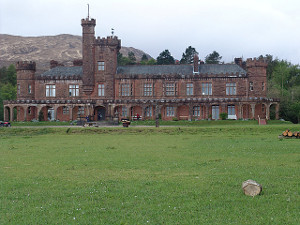
Kinloch Castle (photo: GOC53)
SNH owns the castle and most of the island which is home to the Isle of Rum National Nature Reserve. Although going beyond SNH’s remit, the management and upkeep of the castle comes as part of the ownership responsibility, something that the organisation has invested more than £1m in over the past few years.
The castle was built for the Lancastrian industrialist George Bullough in 1897. Luxuriously furnished, its heyday took place before the First World War after which it slowly went into decline. Along with the island, ownership of the castle passed to SNH’s predecessor, the Nature Conservancy, in 1957. This included its contents which include a rare ‘orchestrion’, a machine made for Queen Victoria and designed to emulate an orchestra.
Despite significant investment the local climate has taken its toll on the sandstone building with the result that its condition has deteriorated largely due to water getting in.
In the past few years SNH investment has been to stabilise the castle tower, repair the oriel windows, replace the lead parapet gutters, valleys and roof ridge tiles and to treat extensive dry rot. However, the building requires significant further investment for its conservation.
The organisation has started a fresh initiative to bring together experts and interested organisations to explore options to secure the castle’s future. This working group will look at how the castle and its historic contents should be managed and ways of achieving this.
Sarah Bentley, SNH’s operations manager for Rum, stressed: “While the nature reserve on Rum is a big attraction for people wanting to come and enjoy the wildlife, Kinloch Castle is also a big attraction. It is a time capsule of the Edwardian era that never ceases to amaze our visitors. The principal rooms have changed little since the Bullough family left and house an extraordinary collection of artefacts. We have been trying for many years to secure resources to restore the castle to its former glory but the scale of funding required has not been available.
“Recently we have produced a conservation plan detailing the actions required to make the building wind and watertight. We are well underway with the first phases of the plan focusing on the roof and upper walls. But there is much more to do and with reduced budgets we are struggling to find the resources needed.
“We recognise the historic and cultural significance of the castle and its contribution to the development of Rum’s community as a visitor attraction for the island.
“Its future should be determined with input from local people and experts in managing historic buildings and artefacts, so we are bringing together a working group to look at the options and help us find the best way to secure a better future for the castle.”
Councillor Allan Henderson, chairman of the Isle of Rum Community Trust, said: “The Isle of Rum community appreciate the restorative work SNH are doing to secure the future of Kinloch castle in these financially challenged times. The castle is a very important part of the community. With its past history and invaluable collection of artefacts it is a vital tourist attraction to the island and the future growth of Kinloch village.”
And Professor Ewan Macdonald, chairman of the Kinloch Castle Friends Association, added: “Kinloch Castle Friends Association was formed to promote the preservation of the castle and its contents for the nation and we have been working with SNH towards that objective. We appreciate the substantial work commissioned by SNH in recent years but much more needs to be done and its long term future secured. So we welcome this consultative approach and will take an active part. We are separately creating a public appeal for funds to restore the rare orchestrion.”
